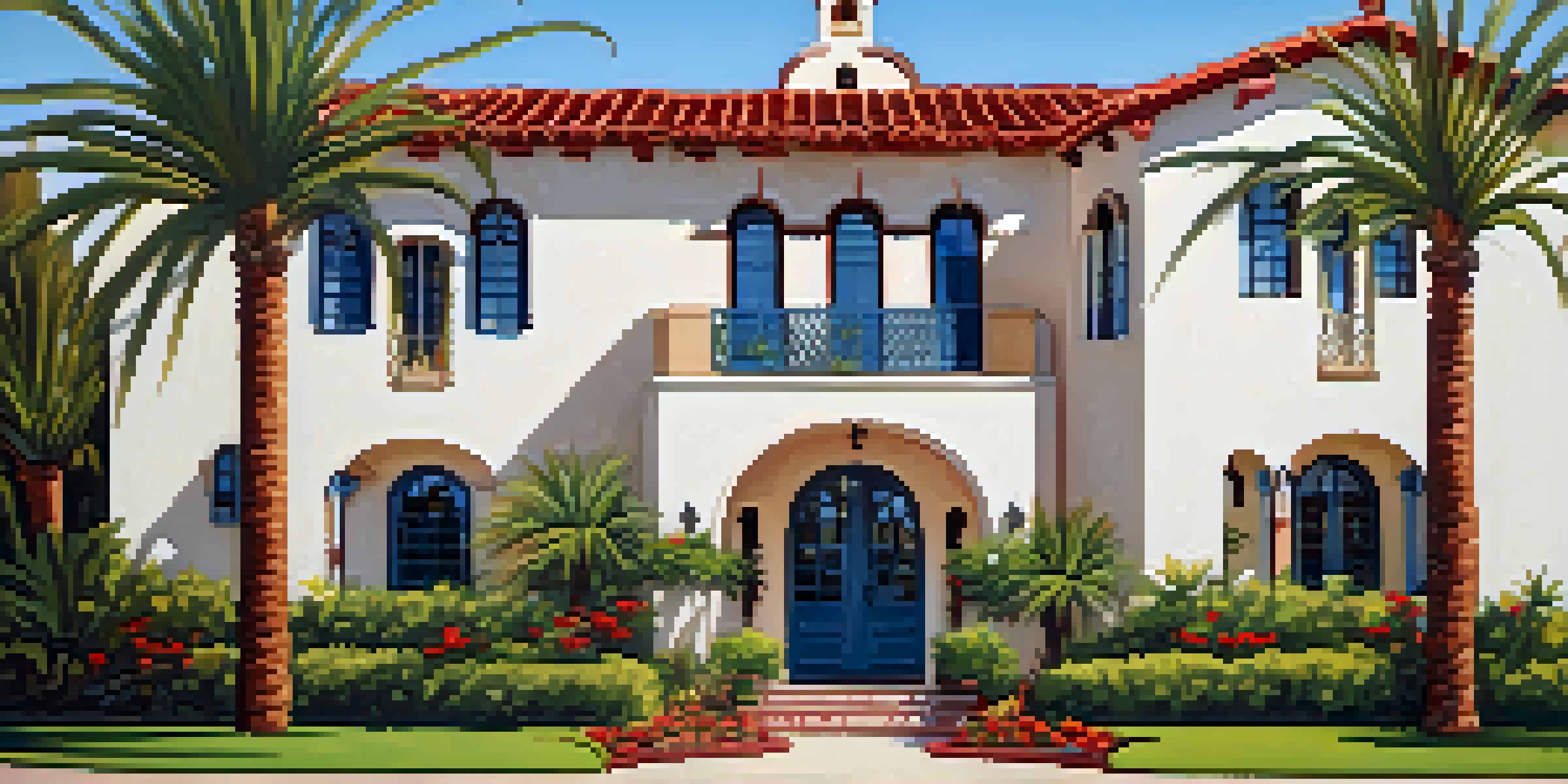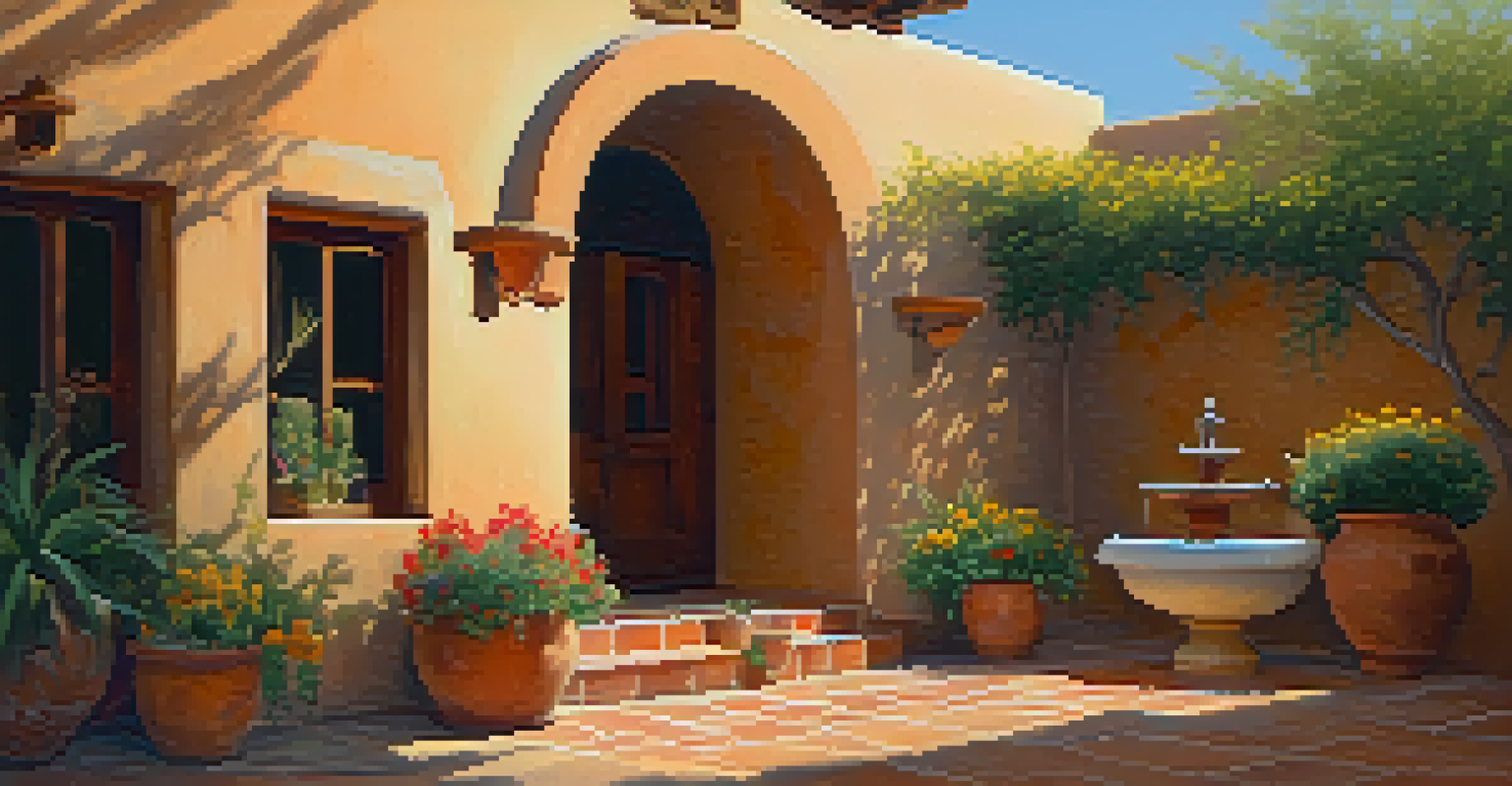Mission Revival Style: Carlsbad's Architectural Heritage

Introduction to Mission Revival Style in Carlsbad
Mission Revival Style is a distinctive architectural movement that emerged in the late 19th century, inspired by California's Spanish missions. Carlsbad, with its rich history, showcases some of the finest examples of this style, blending cultural heritage with beautiful design. This architectural approach seeks to capture the essence of the region's colonial past while creating a unique identity for the community.
Architecture is the learned game, correct and magnificent, of forms assembled in the light.
The style is characterized by its use of stucco exteriors, red-tiled roofs, and arched doorways, all of which echo the aesthetics of the original missions. In Carlsbad, you can see how these elements harmonize with the natural landscape, creating structures that feel both historic and timeless. As we explore this architectural heritage, it's fascinating to see how these buildings contribute to the town's charm and character.
Understanding Mission Revival Style not only enriches our appreciation for Carlsbad’s architecture but also connects us to a broader narrative of California's history. As we delve deeper into this style, we will uncover its influences, key buildings, and the ongoing legacy it leaves in the community.
Historical Context of Mission Revival Architecture
The Mission Revival Style began gaining popularity in the late 1800s as part of the broader Arts and Crafts Movement. It sought to celebrate California's Spanish colonial history while moving away from the more ornate Victorian styles prevalent at the time. This shift was not just about aesthetics; it was also a cultural response to the growing interest in the state’s heritage.

In Carlsbad, this architectural trend was embraced by local builders and architects who recognized the importance of honoring the region's historical roots. As a result, many buildings began to incorporate elements reminiscent of the 21 California missions, making them an integral part of the town's identity. This period marked a significant transition in how communities viewed their architectural landscapes.
Mission Revival Style in Carlsbad
This architectural style reflects California's Spanish mission heritage while enhancing Carlsbad's unique identity.
By weaving together history and design, Mission Revival architecture helped foster a sense of pride within Carlsbad. It encouraged contemporary residents to reflect on their past while providing a visual reminder of the unique cultural narrative that defines the area.
Key Features of Mission Revival Architecture
Mission Revival Style is easily recognizable thanks to its distinct elements. One of the most notable features is the use of adobe-like stucco, which not only provides an authentic appearance but also helps with temperature regulation in a warm climate. Additionally, the iconic red-tiled roofs add a vibrant touch, reminiscent of the traditional Spanish missions.
A building has integrity just like a man. And just as seldom.
Arched doorways and windows are another hallmark of this style, creating an inviting atmosphere that encourages exploration. These features often lead to beautiful courtyards or gardens, blending indoor and outdoor spaces. The use of decorative tile work, particularly in fountains or along walkways, further enhances the charm and character of these buildings.
These architectural elements are not merely for aesthetics; they serve practical purposes as well. For example, the thick walls of stucco help insulate against heat, while the arches provide structural support. Together, these features create a cohesive style that is both functional and visually appealing.
Prominent Examples in Carlsbad
Carlsbad boasts several notable structures that embody the Mission Revival Style. One prime example is the Carlsbad Village Library, which showcases the hallmark stucco exterior and tiled roof typical of this architectural movement. Its design not only serves as a functional space for the community but also stands as a testament to the town's commitment to preserving its heritage.
Another significant building is the St. Patrick’s Catholic Church, which features beautiful arches and intricate tile work that reflect the Mission Revival ethos. This church not only serves as a place of worship but also as a landmark that draws visitors interested in the town's architectural history. The design of these structures invites admiration and serves to educate the public about their historical significance.
Community Drives Preservation Efforts
Local residents and organizations actively work together to maintain and celebrate the town's historic architecture.
These buildings are more than just visually appealing; they represent the community's values and its connection to the past. Each structure tells a story, inviting residents and visitors alike to explore and appreciate Carlsbad's rich architectural heritage.
The Role of Community in Preservation
Preserving Mission Revival architecture in Carlsbad is a collective effort that involves local residents, historians, and government officials. The community recognizes the importance of these structures, not only for their aesthetic value but also for their role in telling the town’s story. Various initiatives, including historical preservation ordinances and community events, have been established to safeguard this architectural legacy.
Local organizations often host tours and educational programs to raise awareness about the significance of Mission Revival buildings. These efforts foster a sense of community pride and encourage residents to take an active role in preserving their historical environment. Additionally, these programs help to engage younger generations, ensuring that the appreciation for this style continues.
Community involvement in preservation efforts highlights a collective commitment to honoring the past while adapting to modern needs. By working together, residents help maintain the charm and character of Carlsbad, making it a vibrant place that respects its architectural heritage.
Challenges Facing Architectural Preservation
While the community is committed to preserving Mission Revival architecture, challenges remain. As urban development continues, the pressure to modernize and repurpose older buildings can sometimes overshadow the desire to maintain historical integrity. Balancing progress with preservation is a constant struggle that many communities face, including Carlsbad.
Additionally, funding for preservation projects can be limited, making it difficult to maintain and restore aging structures. Many historic buildings require specialized care and materials, which can be costly. This financial burden often leads to difficult decisions about which buildings to prioritize for preservation.
Challenges in Architectural Preservation
Urban development pressures and limited funding pose significant challenges to the preservation of Mission Revival buildings.
Despite these challenges, the community remains resilient, finding innovative ways to fund and promote preservation efforts. By advocating for local heritage and engaging with preservation organizations, residents of Carlsbad continue to champion their architectural treasures.
The Future of Mission Revival Style in Carlsbad
Looking ahead, the future of Mission Revival architecture in Carlsbad appears hopeful. As awareness of the significance of these structures increases, so does the community's commitment to preserving them. The ongoing interest in historical architecture, coupled with modern design sensibilities, creates opportunities for innovative preservation efforts.
New developments can incorporate Mission Revival elements, ensuring that the style continues to influence modern architecture in the area. By blending the old with the new, Carlsbad can maintain its unique character while adapting to contemporary needs. This approach fosters a dynamic architectural landscape that honors its heritage.

Ultimately, the preservation of Mission Revival Style in Carlsbad is a testament to the community's dedication to its history. As residents continue to advocate for their architectural heritage, they not only honor the past but also enrich the future of their beloved town.